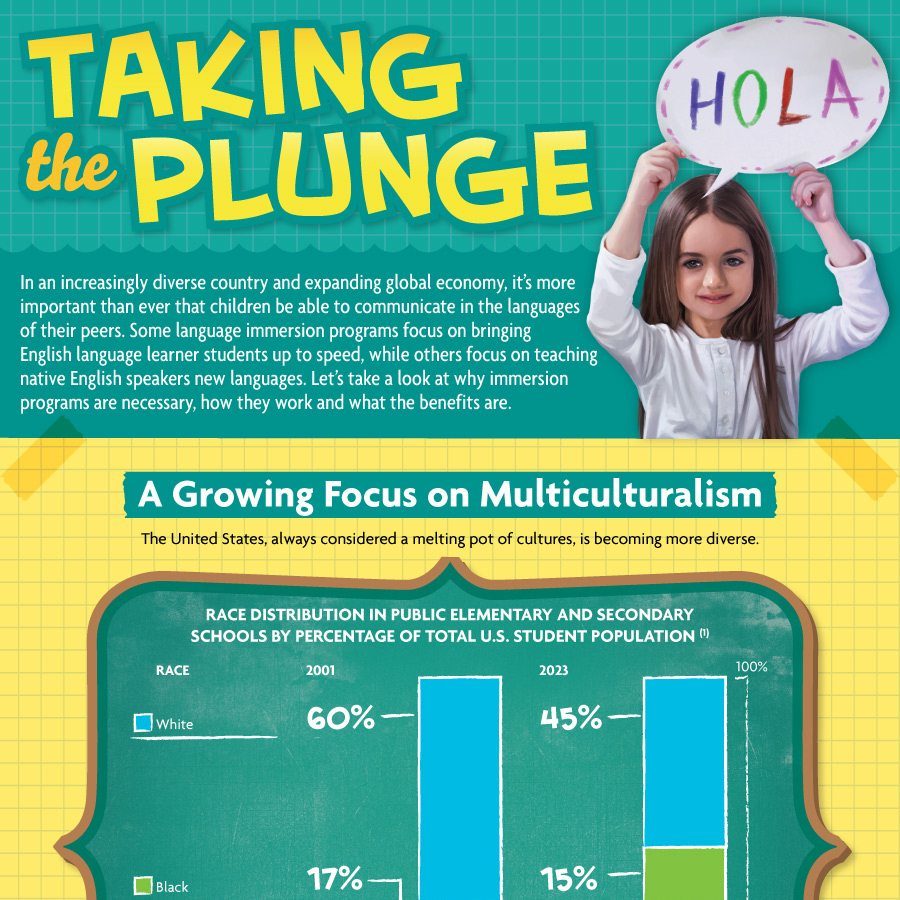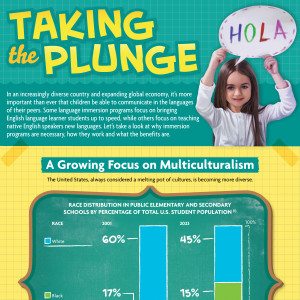Taking the Plunge: Immersion Programs Help Children Learn Other Languages
In an increasingly diverse country and expanding global economy, it’s more important than ever that children be able to communicate in the languages of their peers. Some language immersion programs focus on bringing English language learner students up to speed, while others focus on teaching native English speakers new languages. Let’s take a look at why immersion programs are necessary, how they work and what the benefits are.
A Growing Focus on Multiculturalism
The United States, always considered a melting pot of cultures, is becoming more diverse.
Race distribution in public elementary and secondary schools by percentage of total U.S. student population (1)
Race 2001 2023
White 60% 45%
Black 17% 15%
Hispanic 17% 30%
Asian/Pacific Islander 4% 5%
American Indian/Alaskan Native 1% 1%
Two or more races No data 4%
60.6 million
Number of Americans who speak a language other than English at home (2)
300+
Distinct languages spoken in the United States (2)
Top three languages other than English most commonly spoken at home
Language Percentage of those who speak a language other than English at home (2)
Spanish 62%
Chinese 4.8%
Tagalog 2.6%
9.1%
Percentage of public school students in the U.S. who are English language learners (1)
What Are Language Immersion Programs?
Language immersion programs are programs in which students are taught in a language other than English. Most immersion programs begin in kindergarten and continue through 12th grade. (3)
There are two main types: Foreign language immersion (one-way) and dual language immersion (two-way). (4)
Foreign language immersion (one-way)
Students are primarily native English speakers learning a foreign language. (4)
Dual language immersion (two-way)
Both native English speakers and native speakers of the partner language are enrolled, with neither group making up more than two-thirds of the student population. (4)
Language immersion programs may also be full or partial. (4)
Full immersion
Students are taught in the partner language almost exclusively at first, then gradually in both languages in even portions from fourth grade to 12th grade. This is more common in one-way immersion programs. (4)
Partial immersion
English and the partner language are each used 50% of the time across all grade levels. This is more common in two-way immersion programs. (4)
Here is how a typical day in a kindergarten partial immersion class could go: (5)
Spanish-speaking instructor teaches Spanish language arts and math in the morning
English-speaking instructor teaches English language arts, social studies and science in the afternoon
Language immersion programs of all kinds are available throughout the country.
448
Number of one-way immersion schools in the U.S. (4)
22
Number of languages offered in these schools (4)
Top three languages offered in one-way immersion programs in the U.S. (4)
45% of programs teach Spanish
22% of programs teach French
13% of programs teach Mandarin
Two-way immersion programs, in particular, have grown exponentially in less than a decade.
330
Number of dual-language (two-way) immersion programs in the U.S. in 2006 (6)
2,000
Number of dual-language (two-way) immersion programs in the U.S. today (6)
Languages commonly taught in two-way immersion programs include Spanish, French, Chinese and Korean, but there are also programs for Italian, Japanese, Swedish and Danish, among others. (7, 8)
The Benefits of Immersion
There are a host of proven benefits to language immersion programs.
Positive outcomes for speakers of other languages:
Proficiency in English (9)
Higher grade point averages and increased enrollment in post-secondary education, for Latinos (9)
Decreased dropout rates, in Latino students (6)
These programs are not just beneficial to speakers of other languages, though.
Positive outcomes for native English speakers:
Native-like levels of comprehension in the second language (9)
Achievement equal to or better than non-immersion peers on standardized tests (9)
Sources:
1. http://nces.ed.gov
2. http://www.census.gov
3. http://www.cal.org
4. http://sbo.nn.k12.va.us
5. http://commons.trincoll.edu
6. http://www.bilingualeducation.org
7. http://crede.berkeley.edu
8. http://blogs.edweek.org


